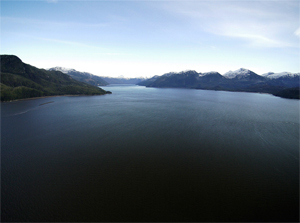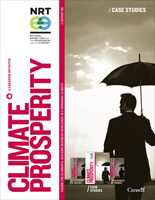Coca-Cola Canada – Case Study
FACING THE ELEMENTS: Building Business Resilience in a Changing Climate
AT A GLANCE // |
Location:Toronto, Ontario Industry:Food and beverage manufacturing Employees (2010):6,300 in Canada Annual per capita consumption of Coca-Cola products by Canadians (2010):236 single servings (8 oz) |
Key adaptation
|
Adaptation
|
Business BenefitsMaintaining competitive position |
Business ChallengesIncreased commodity costs (water, oil, and gas) |
COMPANY OVERVIEW //
TORONTO, ONTARIO
www.cocacola.ca

Skeena Watershed, B.C.
(photo credit: Coca-Cola Canada)
The Coca-Cola Company represents a global business that operates on a local scale through multiple channels. For instance, the Coca-Cola Company manufactures the concentrates, beverage bases and syrups that are used in the production of soft drinks, and sells them to more than 300 bottling manufacturers throughout the world. These bottling partners manufacture, package, merchandise, and distribute the final branded beverages to customers and vending partners. The Coca-Cola Company owns all the Coca-Cola brands and is responsible for consumer brand marketing initiatives.
The Coca-Cola Company operates in Canada through two principal separate entities: Coca-Cola Ltd, which is responsible for advertising, marketing, quality assurance, and control of the Coca-Cola trademarks in Canada; – and Coca-Cola Refreshments Canada, which is in charge of manufacturing, sales and distribution of Coca-Cola products across the country. Lastly, The Minute Maid Company Canada Inc. owns and operates a frozen concentrated and base manufacturing facility in Peterborough, Ontario.
With more than 50 facilities, seven of which are for production, Coca-Cola Canada operates in all ten Canadian provinces and three territories.
BEVERAGE MANUFACTURING, SALES, AND DISTRIBUTION IN A CHANGING CLIMATE
Water is the primary ingredient in Coca-Cola beverage products. As a result, climate change impacts on water availability represent a key business risk for the company globally. Shifts in precipitation amounts and frequency, temperature increases, changes in snow, ice and glacial melt, increased droughts, and extended dry periods can affect availability of fresh water, while extreme weather events (such as storms) can damage water infrastructure and lead to pollution of water supplies. Climate change is also likely to increase demand for irrigation and drinking water in some areas, which can lead to heightened competition and water scarcity, especially in areas of the world that already experience periods of water stress.
Production of Coca-Cola’s products requires a number of raw agricultural inputs, such as sugar, corn, and citrus. Because agriculture is highly sensitive to climate conditions, Coca-Cola’s beverage manufacturing is vulnerable to crop yields disruptions. Changes in temperature, soil moisture, rainfall, incidence of pests and diseases, and frequency and intensity of extreme weather events (including floods, droughts and storms), will have consequences for crop quality, supply, and price.
Because it relies on stable transport and logistics systems, product distribution is also susceptible to transport disruptions or delays that may be more likely in a changing climate.
Finally, weather significantly influences consumer preferences and beverage sales. This will translate into both seasonal opportunities and risks, depending on the product concerned.
A FOCUS ON WATER STEWARDSHIP
Global climate change has widespread implications for the planet and the communities where Coca-Cola operates. Water resources, public health, agriculture and more areas are at risk, and Coca-Cola recognizes that climate change has the potential to significantly affect the sustainability of the company’s business and supply chain.
The Coca-Cola Company has made a commitment to become ‘water neutral’ throughout its global operations by 2020. The aim of this commitment is to return to communities and nature an amount of water equivalent to what they use in their beverages and production.
Because water is at the core of the company’s operations and is intricately linked to both climate change and carbon, the company has adopted a global and holistic Water Stewardship Strategy. This strategy sets objectives in three areas globally:
// Improve water efficiency;
// Increase the amount of water recycled and the proportion of clean water returned to the environment; and
// Support freshwater conservation through watershed protection (for example, by eliminating invasive species in water bodies, or by restoring wetlands).
While the impetus for these initiatives is not strictly climate change, Coca-Cola recognizes that they help the company to build resilience against potential climate change impacts, while also helping to build the adaptive capacity of surrounding ecosystems and communities that depend on shared water resources.
To promote responsible water resource management, The Coca-Cola Company has adopted a corporate source water protection standard.50 This standard requires that by 2012 all Coca-Cola manufacturing plants must do the following:
// Form a water resource management team.
// Work with experts to complete a Source Water Vulnerability Assessment (SVA) to produce an inventory of watershed-level risks.
// Prepare and implement a Source Water Protection Plan (SWPP).
// Maintain and update the SWPP as-needed, at a minimum every five years.
The impacts of a changing climate are considered within SVAs, together with: infrastructure pressure, pricing, drought, competing use, increasing demand, regulatory limits and social acceptance. The SVA are based upon an independent scientific review of the watershed in question. This review is accompanied by qualitative input from local officials and non-government organizations (NGOs).
Source Water Protection Plans are a roadmap toward a more sustainable watershed. These roadmaps typically include an outline of the appropriate role Coca-Cola should play in the watershed stewardship as well as a framework for working with local officials, conservation authorities, the public, and NGOs. To date, Coca-Cola Canada has completed SVAs at five manufacturing facilities and started preliminary water risk assessments in the remaining two facilities.
To achieve optimal results, Coca-Cola Canada works in partnership with NGO’s, such as World Wildlife Fund (WWF)-Canada, and local governments. External third-party reviewers also assure the company’s water stewardship initiatives.
A FOCUS ON PUBLIC AWARENESS
Coca-Cola and WWF are teaming to help protect the polar bear’s home. Together they are raising awareness and funds to help create a safe haven for polar bears through a project called ‘Arctic Home’. Coca-Cola is making a contribution of $2 million to WWF over five years. Coca-Cola invites everyone to join the effort and will match all individual donations made in Canada and the U.S. by March 15, 2012, up to US$1 million. Furthermore, to call attention to this cause, for a limited time Coke is turning its red cans white – a first in Coca-Cola’s history.
Coca-Cola’s holiday advertising campaigns have used polar bears for more than 80 years. In 2011, Coca-Cola decided to use the force of its iconic Christmas campaigns to raise public awareness of the effects of climate change on Arctic communities and ecosystems, including polar bears. The campaign is designed to raise awareness of the impact of climate change on the Arctic and is a call to action for individuals to support WWF in its efforts to protect the Arctic and polar bears.
BENEFITS AND/OR CHALLENGES
Coca-Cola Canada has observed that society is increasingly aware of the implications of climate change, and increasingly requires renowned brands to demonstrate sustainable practices. By adopting a holistic approach to sustainability, through a climate change lens, the company aims to preserve its leader position in the beverage industry.
PERSPECTIVES ON GOVERNMENT ROLES
To achieve long-term sustainability, the company believes that it is essential for businesses to work alongside government and society. For example, once a manufacturing plant has completed its SVA, Coca-Cola Canada reaches out to the communities and local governments that are connected to the watershed to discuss the water resource management actions that each group can take to ensure long-term sustainability.
[50] The Coca-Cola Company 2011









































